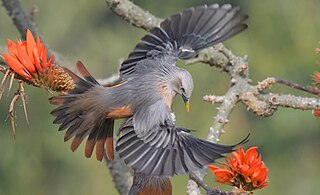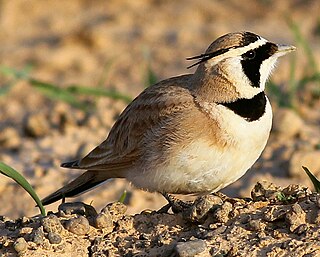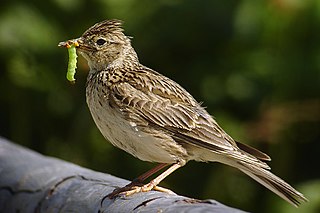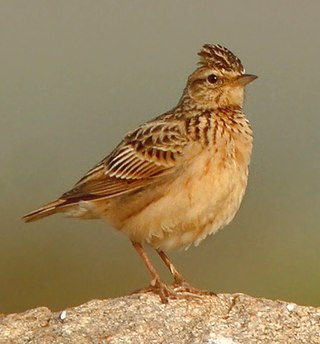
The bimaculated lark breeds in warm temperate countries eastwards from Turkey into Central Asia. It is the eastern counterpart of its relative, the calandra lark.

The crested lark is a species of lark widespread across Eurasia and northern Africa. It is a non-migratory bird, but can occasionally be found as a vagrant in Great Britain.

Thekla's lark, also known as the Thekla lark, is a species of lark that breeds on the Iberian Peninsula, in northern Africa, and sub-Saharan Africa from Senegal to Somalia. It is a sedentary (non-migratory) species. This is a common bird of dry open country, often at some altitude. Thekla's lark was named by Alfred Edmund Brehm in 1857 for his recently deceased sister Thekla Brehm (1833–1857). The name is a modern Greek one, Θέκλα, which comes from ancient Greek Θεόκλεια (Theokleia) derived from θεός and κλέος. The population is declining in Spain, but this is a common bird with a very wide range and the International Union for Conservation of Nature has rated its conservation status as being of "least concern".

The chestnut-tailed starling, also called grey-headed starling and grey-headed myna is a member of the starling family. It is a resident or partially migratory species found in wooded habitats in India and Southeast Asia. The species name is after the distribution of a former subspecies in the Malabar region. While the chestnut-tailed starling is a winter visitor to peninsular India, the closely related resident breeding population with a white head is now treated as a full species, the Malabar starling.

Temminck's lark or Temminck's horned lark, is a bird species of the family Alaudidae. It breeds across much of north Africa, through northern Saudi Arabia to western Iraq. It is mainly resident, but some populations of this passerine bird are partially migratory, moving further south in winter. This bird's common name commemorates the Dutch naturalist Coenraad Jacob Temminck. The population is declining in Israel and may also be declining elsewhere, probably as a result of habitat loss. Nevertheless, this is a common bird in many parts of its wide range and the International Union for Conservation of Nature has rated its conservation status as being of "least concern".

Alauda is a genus of larks found across much of Europe, Asia and in the mountains of north Africa, and one of the species endemic to the islet of Raso in the Cape Verde Islands. Further, at least two additional species are known from the fossil record. The current genus name is from Latin alauda, "lark". Pliny the Elder thought the word was originally of Celtic origin.

Melanocorypha is a small genus of birds in the lark family. The current genus name, Melanocorypha is from Ancient Greek melas, "black", and koruphos a term used by ancient writer for a now unknown bird, but here confused with korudos, "lark".

The singing bush lark or Horsfield's bush lark is a species of lark which inhabits grassland throughout most of Australia and much of Southeast Asia. It was described by the American naturalist Thomas Horsfield.

Sykes's lark is a species of lark found in the dry open country of India. Its distribution is mainly restricted to central India, although stray records have been found elsewhere on the sub-continent. It is identified by its prominent crest and its overall rufous colouration. It has streaks on its breast which are less prominent than those found in the Oriental skylark.

The Oriental skylark, also known as the small skylark, is a species of skylark found in the southern, central and eastern Palearctic. Like other skylarks, it is found in open grassland where it feeds on seeds and insects.

Galerida is a genus of birds in the family Alaudidae. The current scientific name is derived from Latin. Galerida was the name for a lark with a crest, from galerum, "cap". The name Galerida is synonymous with the earlier genus names Calendula, Heliocorys and Ptilocorys.

The large-billed lark or southern thick-billed lark is a small passerine bird found in southern Africa. The name "large-billed lark" may also refer to Bradfield's lark. The name "thick-billed lark" more commonly refers to the species of the same name.

The sand lark is a small passerine bird in the lark family, Alaudidae, found in southern Asia. It is somewhat similar to, but smaller than the short-toed larks.

Hume's short-toed lark is a species of lark in the family Alaudidae. It is found in south-central Asia from Iran and Kazakhstan to China.

The black-crowned sparrow-lark is a species of lark in the family Alaudidae. It is found across northern Africa from Mauritania through the Middle East to north-western India. Its natural habitat is dry savanna.


















